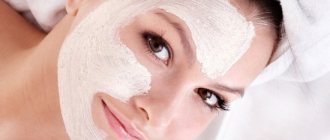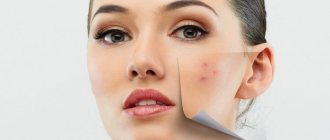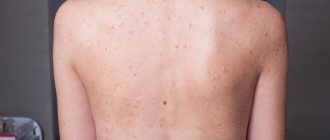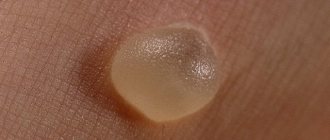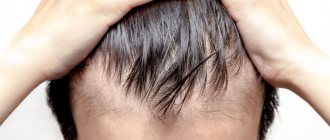Cold allergy is one of many types of negative responses of the body to various external stimuli. The very name of this allergy suggests that an allergic reaction occurs under the influence of cold temperatures.
Until recently, medicine rejected such a diagnosis, since there is no allergen that provokes a specific reaction of the body as such, there is only a physical effect - cold. No allergen means no allergies.
But when exposed to cold air, some sensitive people experience a significant release of histamine, which causes reactions similar to other types of allergies - the development of swelling, vasodilation, redness and itching of the skin and mucous membranes. This is a response to a decrease in the temperature of the skin's thermal receptors.
Causes of cold allergies
Why does cold allergy occur? Medicine does not yet know the exact answer to this question, but with the following factors, particularly sensitive people may experience this strange type of allergy:
- When there is a sharp change in a person’s presence in an environment with normal air temperature to an environment with low temperature - in winter, especially in windy weather
- In contact with cold water - in everyday life when washing dishes, cleaning, swimming in open water
- When drinking very cold drinks or cold food
Allergy to cold often develops after severe illness and long-term treatment with antibiotics; it is believed that it has a genetic predisposition; it can occur against the background of infectious diseases (for example, tuberculosis) or parasitic diseases (roundworms in children, adults, pinworms in children, giardiasis.
In a strong, hardened organism with a strong immune system, such temperature changes do not cause any reactions.
However, in the event of a decrease in protective forces, systemic disorders, serious illnesses, or metabolic disorders in the body, this type of allergy may occur. Stress, as we know, is the most important risk factor for immune failure, so stress-resistant people tend to get sick less often and have good health.
Symptoms of cold allergy
Symptoms of an allergic reaction include skin lesions on parts of the body not protected by clothing (hands, face), irritation of the mucous membranes (nose, trachea, throat). There are several types of pathology, each of which has specific features:
- Cold urticaria
, characterized by severe itching and numerous rashes on the body, similar in type to blisters and swelling that appear upon contact with nettles.
- Cold dermatitis
, which causes severe peeling of the skin, causing redness and swelling of the dermis. A few days after contact with cold, small blisters form on the body, the opening of which threatens the formation of erosions, and then the dermis becomes covered with scabs and scars. - Cold conjunctivitis
, which involves severe tearing in the cold, stinging and pain in the eye area.
- Cold rhinitis
, characterized by a feeling of nasal congestion when being in an environment with sub-zero temperatures. As soon as a person is indoors, the symptoms of a runny nose disappear. - Cold asthma
, manifested in laryngeal edema, bronchospasms and often observed in people prone to pneumonia.
Attention!
This type of allergy is often confused with acute respiratory viral infections, acute respiratory infections and other viral ailments.
However, allergies rarely involve an increase in body temperature. If you find a rash, blisters on the skin, burning and itching of the dermis, swelling of the mucous membrane, headache and chills, immediately consult a doctor, who is obliged to diagnose the presence of cold allergies and, if the result is positive, help the patient get rid of the problem.
Provoking factors for the development of cold allergies
- The presence of allergic reactions to other irritants - food, pollen (allergy to poplar fluff), household allergies
- Some infectious diseases - mumps, measles (see symptoms of measles in adults), mycoplasma pneumonia, rubella
- Thyroid diseases, systemic lupus erythematosus, cancer
- The presence of chronic diseases - sinusitis, sinusitis, various worm infections, intestinal dysbiosis
- Recurrent skin diseases – neurodermatitis, eczema, psoriasis
- Hereditary factor
There are cases when such a reaction is hereditary in nature, that is, it is inherited and most often it is the body’s reaction to windy weather than to cold. The symptom of such an allergy is a burning sensation, not itching of the skin.
Who is susceptible to cold allergies?
An allergic reaction to the cold can occur in absolutely all people. But women are most susceptible to the disease.
Important! According to the results of research by scientists from Finland, among 100 people suffering from cold allergies, almost 70% are women. The average age of patients who first encountered the disease ranges from 23 to 25 years.
Cold urticaria occurs in 30% of people who suffer from an allergic reaction to various irritants. This happens especially often with heat allergies and urticarial dermographism. If the disease is uncomplicated, after 5-7 years it may subside; this is observed in 87% of cases.
Typically, cold allergies develop in children over 2-3 years of age and extremely rarely until the child is one and a half years old.
The most dangerous is general cooling: with systemic damage, for example, a drop in blood pressure, fainting or suffocation, a person can die even just after swimming in cold water.
How does an allergy to cold manifest itself?
How does an allergy to cold manifest itself? Symptoms of such an allergy can have various forms of manifestation - from mild symptoms that disappear some time after contact with a cold environment, to serious recurrent skin rashes.
Skin manifestations are the most common signs. These include redness, swelling, itching of open areas of the body that have come into contact with a cold environment. After some time, the skin begins to hurt, itch, and may become blistered, similar to hives.
Cold allergies in children can even affect the inner surface of the legs, thighs, knees and manifest themselves in the form of hives. The rash is pink, dense, itchy, but goes away within a few hours. There are cases when, after a cold, the skin not only turns red and itches, but also becomes covered with a layer that begins to peel off, as with dermatitis. Sometimes bruises appear at the site of the allergy over time.
Most often, cold allergies occur on the face and hands, since these places are more exposed to the external environment, they are always open and more vulnerable.
General malaise - increased blood pressure, shortness of breath, headache and weakness.
Allergic rhinitis - the appearance of a runny nose, sneezing when going out into cold air. Swelling of the mucous membranes of the nose can either greatly complicate nasal breathing or completely block it, and upon returning to a warm room, all allergy symptoms disappear.
Signs of allergic conjunctivitis are tearing, swelling around the eyes, swelling of the eyelids, pain in the eyes. Hypersensitivity to bright light also occurs. To differentiate the diagnosis, you should definitely consult an ophthalmologist and dermatologist, since if profuse lacrimation occurs in the cold, this may be a sign of tick-borne infection (demodex) or fungus, etc.
Types of cold allergies
Cold urticaria is divided into several types:
- Acute or chronic. With this type of allergy, severe irritation, rash and itching begins on the face and hands, and blisters appear. Certain areas of the body may turn red; in appearance it looks like insect bites. The rashes are often accompanied by lethargy, chills, and pain in the joints and muscles. Attacks of exacerbation can continue for several weeks and even months while it is cold outside.
- Recurrent. It usually occurs at certain times of the year - autumn, winter and cold spring. An exacerbation of an allergic reaction to cold water can begin at any season.
- Reflex. It can be of a general or local type, very similar to cholinergic urticaria. Hyperemia and rash occur around the damaged area, while the cooled area itself is not affected.
- Hereditary. Passed from generation to generation according to an autosomal dominant trait. The disease is expressed in the form of maculopapular rashes and burning. Sometimes allergies are accompanied by fever, chills, joint pain and leukocytosis. This form is often confused with chronic idiopathic urticaria due to the characteristic itching and burning sensation.
Cold allergies can also manifest themselves in the following forms:
- Cold rhinitis. Characterized by the fact that nasal discharge is observed only in the cold. When a person enters a warm room, the runny nose stops.
- Cold conjunctivitis. On frosty days, the patient's eyes may become very sore and watery.
- Cold dermatitis. The skin is very itchy and itchy. In severe cases of the disease, swelling of the entire body may occur.
- Cold erythema. After a long stay in the cold, the affected area becomes very red and painful.
Manifestations of cold allergies
Diagnosis of cold allergies
If you experience similar symptoms, then first of all you need to visit a therapist and an immunologist - an allergist. After a set of diagnostic and laboratory tests, it will be possible to accurately determine the cause of the allergic reaction. Cold allergies, the symptoms of which are similar to other types of allergic reactions, should be differentiated from a number of other diseases.
- Sometimes in small children of preschool age, cold allergies on the face are similar to atopic dermatitis, neurodermatitis.
- Often similar allergic symptoms occur with idiopathic dermatosis. With this disease, heat and cold skin receptors are deregulated. Swelling, lacrimation, sneezing, and difficulty breathing occur in both cold and heat.
- Intolerance to the fur of some animals - rabbits, mink, chinchillas, woolen fabrics, sheep's wool - can also be confused with an allergy to cold. When putting on clothes and going out into the cold, a person returns with a rash and swelling of the nasopharynx; as a result, this can be assessed as a reaction to the cold, and not an allergy to wool or fur.
- The situation is similar with perfume products. Typically, perfume is applied to the forearm, neck, face, and an allergic rash can be caused by cosmetics and perfumes, and not by cold.
When symptoms appear, it is important to make a correct diagnosis, and only after differentiating the signs of allergy can a doctor confirm this disease. Then, the question arises: is an allergy to cold treatable?
Causes of cold skin allergies
According to researchers, about 30% of people experience discomfort due to the adverse effects of low temperatures. Experts are sure: cold allergy is not an independent disease, but only a symptom that accompanies some kind of physical disease. The body, weakened by a long and latent course of the disease, gives a sharp response to cold, so the true reasons for the body’s non-standard reaction to cold have not yet been established.
There are suggestions that the development of allergies to cold is associated with the production of special cryoglobulin proteins in the body, which, in fact, are the “culprits” for the activation of histamine, which causes allergic reactions. And the main trigger for this is cold.
Various predisposing factors help this trigger mechanism work: decreased immunity, infectious, colds and parasitic diseases. Chronic throat diseases, untreated teeth, and inflammatory processes in the gynecological area in women can trigger an allergic reaction to cold.
A cold allergic reaction on the skin is usually caused by the following factors: • interaction of the skin with cold objects, cold air, snow, moisture or cool water; • frostbite of individual parts of the body or general frostbite of the body; • Eating cold foods, such as ice cream or drinks with ice.
Exposed areas of the face and hands are especially susceptible to the negative effects of cold, although an allergic reaction can occur throughout the body.
How to treat allergies to cold
The inability to eliminate an allergen such as cold makes the fight against such an illness quite difficult. If the patient is diagnosed with an allergy to cold, treatment in this case is purely symptomatic. It is only possible with the help of antihistamines to slightly reduce its manifestations, or to protect exposed areas of the body as much as possible from exposure to negative temperatures. You can reduce the occurrence of allergic reactions if:
- Before going out into the cold, lubricate your face and hands with baby cream, for adults, with any rich cream. Lips should be lubricated with hygienic lipstick. This will partially protect uncovered areas of skin from cold air.
- Badger fat has a very good effect; it is rich in unsaturated fatty acids and vitamins B and A, which have only a positive effect on the skin. 20 minutes before going out into the cold, you can lubricate exposed areas of the skin with badger fat (lips, cheeks, nose, hands); if there is no serious liver damage, then you can consume it orally 40 minutes before. before breakfast, 1 tbsp. a spoonful of fat.
- Long warm gloves, preferably waterproof mittens for children, warm scarves, it is preferable to have hoods in outerwear - this will effectively protect from the wind and better retain heat.
- Medicinal herbs, if there is no allergy to them, can also help with the development of urticaria, which appears as an allergy to cold. Burdock root, tricolor violet and walnut leaves are very useful. To collect, mix the raw materials in equal proportions, 2 s. Pour a tablespoon of the mixture into a glass of boiling water, leave for 1 hour, strain, consume the resulting broth 60 ml 3 times a day.
- Pine cones (see pine cones for stroke) or spruce cones also have beneficial properties; 4 cones are required to prepare the decoction; they should be ground in a mill or meat grinder, poured with water and simmered over low heat for half an hour. After straining the broth, you can wipe it on chapped and rough skin every evening.
- If you have a cold allergy, the symptoms of which are minor, then gradual hardening and rubbing can strengthen the immune system and reduce the body's reaction. But for young children and people with intense symptoms, hardening is contraindicated, as it is fraught with the development of complications in the form of anaphylactic shock, Quincke's edema, and laryngeal edema.
- During the cold season, you can use antihistamines (A complete list of all allergy pills is in our article.)
Cold allergy on feet
Very often, cold allergies on the legs (photo 3) are more reminiscent of a rash like urticaria. Cold allergies look like a massive rash all over the leg, usually appearing near the knees and on the upper thigh. Hives spots become multiple in nature; sometimes frost allergies on the legs look like one big spot into which small spots merge with each other.
Cold allergies on the body in the lower extremities usually appear during the cold season. The occurrence is associated with the effect of low temperature on the human body. The legs are most often affected, although allergies in particularly sensitive patients appear on the stomach and shoulders, but such phenomena are rare. The main target is the upper thighs and the area up to the knee.
A characteristic sign of such an allergy is total swelling. The legs increase in size, as if they are swollen. The skin becomes intensely pink, its surface itches, and when scratched, the itching sensation increases.
A burning sensation on the skin also occurs with allergies, but usually occurs when moving to a warm room. Patients with sensitive skin experience pain when touching their feet, especially in the first moments after warming up.
The allergic response decreases after some time, the skin gradually takes on its previous appearance, swelling may remain for some time, which then also goes away. All types of cold allergies, including those on the legs, can be treated with third-generation antihistamines based on cetirizine.
What it is
Cold allergies are called pseudo-allergies, because low temperatures cannot be considered an allergen - antibodies to them, as you might guess, are not produced. But this does not change the essence, especially for those whose skin reacts sharply to frost.
An allergy to cold is truly an immune disease. A few years ago, scientists even identified a genetic mutation that determines a tendency to it.
Cold allergy – skin reaction to low temperatures © iStock
Video selection
Cold allergy is the body’s reaction to low temperatures, manifested in the form of skin irritation. On the dermis susceptible to frost, peeling and itching, erosion and redness appear.
This is interesting!
Not so long ago, medicine did not officially recognize the diagnosis of “cold allergy”, as it rejected the possibility of considering temperature as an allergen. No allergen means no reaction to it. However, studies have shown that some people, under the influence of “minus”, experience releases of histamine, the excess of which contributes to vasodilation, the appearance of edema, and causing itching of the skin and mucous membranes.
Development mechanism
Typically, allergens (pollen, food, etc.), once in the body, combine with immunoglobulins - protective proteins, the main “actors” of the human immune system. As a result, so-called immune complexes are formed. They trigger a chain of allergic reactions:
With an allergy to cold, immunoglobulins do not encounter any allergen, but under the influence of low temperature they begin to connect with each other, forming the same immune complexes that manage to trigger an allergic reaction.
Symptoms
If you notice these signs, you most likely have a cold allergy.
Small blisters (urticaria).
Itching and/or burning.
Blisters, like burns.
Swelling around the eyes and lips.
Runny nose that begins outdoors but goes away in warmth.
Redness is one of the main symptoms of cold allergies © iStock
If we talk about the skin, cold urticaria appears most often on the face and hands - that is, on exposed parts of the body that are more exposed to low temperatures. Although irritation can also occur under clothing if you are cold.
How to check if you are allergic to cold
We come back from the cold flushed and ruddy, this is a protective reaction of the skin: blood circulation increases to replenish heat loss. However, in case of an allergy to cold, the blush does not go away even in the warmth for several hours.
To find out if you really have a cold allergy, doctors advise doing a simple test. Place an ice cube on your elbow or wrist and leave for 5-10 minutes. If you have an allergy, redness will appear in the area where the ice was placed or around it, swelling and itching may occur.
Cold allergies are tested using an ice cube © iStock
Cold allergy test
To find out whether a person is allergic to cold, you can do a provocative test. To do this, you need to wrap a piece of ice in a plastic bag (so as not to confuse a cold allergy with an aquagenic allergy to water) and place it on the back of your forearm for 15 minutes.
If severe redness, swelling, rashes or blisters appear on a cooled area of the body, and the skin itches and hurts, then the result is positive. If you have a strong sensitivity to cold, symptoms may occur even after half a minute.
It should be noted that if the disease develops atypically or the reaction is delayed, the result may not be accurate. In this case, a laboratory blood test should be done. If agglutinins, cryoglobulins and cryofibrinogens are detected in the serum, this indicates the presence of the disease.
A small piece of ice will help determine if you are allergic to cold.
Who is at risk of cold allergies?
In this list we tried to include everyone who is at risk.
Children, because their immune system is not yet fully developed.
Allergy sufferers prone to dermatitis.
People who are genetically predisposed to cold allergies.
People after traumatic brain injury.
Women with hormonal disorders.
Manifestations of cold allergies are possible already at +4 °C. It should be taken into account that in a strong wind, a temperature of +8 ° C may well be felt by the skin as “about 0”, which means that an immune reaction is not excluded.
Quite often, cold allergies can accompany serious illnesses, from mononucleosis to liver disease and gastrointestinal infections. If in doubt, consult your doctor.
How to prevent cold allergies
These preventive measures are relevant for both adults and children. Those with sensitive skin should also take them into account.
Wear clothes that suit the season : a hood and a warm scarf that covers your face from the wind as much as possible, gloves or mittens to keep your whole body warm.
Do not wear underwear made of wool or synthetics , which themselves can cause an allergic reaction.
Drink warm tea (or any other hot drink) some time before going out into the cold.
Take antihistamines if prescribed by your doctor.
Keep your home cool by ventilating the rooms often and using a humidifier.
Take care of your skin and use protective products on your face, hands and lips before going outside.
A cup of hot tea “treats” cold allergies © iStock
Treatment of cold allergies with folk remedies
Cold allergies can also be treated with folk remedies.
Raspberries. Pour 0.5 liters of water into 50 g of dry crushed raspberry roots. Simmer over low heat for 30-40 minutes. Then strain and cool. Drink 2 tbsp of the decoction before going out in the morning, after lunch and before bed. spoons. Treatment period is 2 months. If you do not skip taking folk remedies, medications will not be needed. Also drink the decoction for preventive purposes, starting 2 months before the winter cold. Then in winter, you will not feel any symptoms of the disease.
Sunflower seeds and regular red beets. Just eat more unsalted seeds and beets in all types in winter, and also drink half a glass three times a day of freshly squeezed beet juice.
Celery. For cold allergies, drink freshly squeezed celery root juice. It should be taken 0.5 teaspoon before meals, three times a day.
Mumiyo. For a medicinal solution, take 1 g of mummy per 1 liter of boiling water. High-quality raw materials dissolve without sediment. Take once a day in the morning, adults 100 ml. It is possible to treat cold allergies in children in this way, but a single dose for a child 1-3 years old is 50 ml, and for a primary school child - 70 ml.
For cold allergies on the hands and face, you can lubricate the skin with a solution of a higher concentration of 1 g per 100 ml of water.
Blueberries. Grind fresh blueberries and apply them as compresses to the affected areas of the skin.
Emulsion based on celandine, burdock, mint and calendula. If a cold allergy appears on the face, there is no better remedy. Grind and mix 10 g of celandine herb, mint leaves, burdock root and calendula flowers. 5 tbsp. Pour a tablespoon of the herbal mixture with sunflower oil, so that the oil level is 1 cm above the level of the raw material, leave for 24 hours. Sterilize in a water bath, stirring gently. Strain, cool and lubricate the skin. The emulsion perfectly relieves itching and dry skin.
Pine shoots in vegetable oil. In cases where a child’s allergy to cold is manifested by dryness, peeling and redness of the skin, the formation of small cracks and itching, an infusion of pine buds in vegetable oil is prepared. Young pine shoots are infused with vegetable oil in a 1:1 ratio in a dark place for about 5 months. The infusion is gently rubbed into the baby's skin.
Birch sap to reduce allergic swelling. Birch sap is an excellent restorative and regulating salt metabolism with a mild diuretic effect. Its consumption helps to quickly eliminate allergic swelling of the hands and face. You can consume it in unlimited quantities, but for an adult the daily dose should be at least 1 liter. For cold allergies in children, this dose, depending on age, is from 200 to 500 ml. To improve the taste, you can add a little raisins, honey, dried fruits or lemon to the juice, leave for about an hour, and then drink. Not only healthy, but also very tasty.
Walnut tincture. Walnut tincture, which has anti-inflammatory, bactericidal and anti-allergic effects, is prepared from fresh leaves and green pericarp of the walnut, at the rate of 50 g of crushed raw materials per 100 g of vodka or ethyl alcohol diluted to 40°C. Infuse in a tightly closed glass container for a week, shaking daily. The strained tincture is taken 25 drops 3 times a day 20 minutes before meals, diluted in a quarter glass of water. If a child is allergic to cold and has a cough and shortness of breath, it is recommended to give as many drops of tincture as the child is old.
Schisandra juice. If you are bothered by severe itching caused by cold allergies on the face, hands or other parts of the body, you can carefully wipe the skin with lemongrass juice when returning to a warm room, trying not to injure it.
Blue cornflower for the treatment of allergic conjunctivitis. In case of conjunctivitis, as a symptom of cold allergy, treatment is also possible with the help of rinses and lotions from decoctions of medicinal herbs. Most often, a decoction of blue cornflower flowers is used. 1 tbsp. a spoonful of raw materials and 200 ml of boiling water, leave for about 30 minutes and then filter. The resulting decoction is used to wash the eyes or make a lotion from it, soaking gauze pads in it and placing them on the eyes for 15 minutes.
Pine needle baths. Collect twigs along with needles, boil and take baths with this decoction. It is also necessary to wash your face with it in the morning and evening. Take water and needles “by eye”; there are no strict restrictions here.
Before using folk remedies, be sure to consult your doctor!
Skin care for cold sensitive skin
Low temperature, snow, wind, dry indoor air - all this is additional stress and strain on the skin. For many people, it becomes more sensitive in winter.
This is what Vichy medical expert Elena Eliseeva advises in this case.
Maximum gentle cleansing . If you prefer to wash your face with water, then replace the gel with foam or wash-off oil. If without water, milk will do.
Instead of scrubs and peels , in order not to give up exfoliation at all, use a soft sponge for washing (made of quilted cotton or latex).
Finish cleansing the skin with an alcohol-free physiological tonic: the tissues may not have enough of their own strength to correct the acid-base balance.
The cream should contain panthenol, allantoin or bisabolol. And if this is a morning product, silicones are acceptable: natural oils, for all their value, will not provide the skin with such a strong barrier as a thin silicone mantle.
Foundation is necessary in winter : it acts as a “clothing” that protects the epidermis from cold and wind. It is better to choose a product that is water-free or based on silicone oils.
Prevention of cold allergies
If, fortunately, you are not yet familiar with cold allergies, make a little effort to prevent it, which is very similar to methods for preventing frostbite in the body:
Before going outside during the cold season, lubricate exposed areas of the body with special protective creams against cold and wind. A high-quality nourishing cream is applied to the face half an hour before going outside.
Don't neglect gloves, seasonal hats, warm underwear and tights. Underwear must be made of cotton, because... Synthetics and wool increase the manifestations of cold urticaria. If possible, wear a hood, and the deeper it is, the better. Don't forget about a warm scarf.
At the first signs of a cold allergy, reduce your time outside and do not get too cold.
Hardening by dousing is also a good preventive measure, but you need to start it in the summer and gradually reduce the water temperature.
Before going outside, try not to wash your face and other areas of the body bordering the street with soap, because... it dries out the skin, removing its natural protective film, thereby exposing the skin to the harmful effects of cold on the body.
To avoid cold allergies, as a comprehensive measure, you need to monitor your diet. Meals must be regular. It is worth excluding everything that irritates the mucous membrane of the gastrointestinal tract (GIT), smoked and deep-fried meat - first of all. It is necessary to introduce foods rich in vitamin F (omega-3 fatty acids) into the diet - sea fish and high-quality vegetable oils.
Protective products for skin during cold periods
Nourishing and rich face cream “Life-giving Moisture”, Garnier - its properties are ensured by herbal elixir and camellia oils. The cream nourishes the skin and maintains its moisture for 24 hours, creates a hydrolipidic barrier and protection from adverse external conditions.
Nourishing cream for deep restoration of dry and very dry skin Nutritic Intense Riche, La Roche-Posay, despite its fairly dense texture, spreads easily and is quickly absorbed, leaving a weightless protective film on the skin. Shea butter and MP lipids stimulate the restoration of the skin's lipid barrier. Intensely moisturizes.
Emollience, SkinCeuticals Moisturizing & Repairing Treatment for Normal to Dry Skin is formulated for people living in cold or high altitude climates. The base consists of grape seed, rose hip, macadamia oils, as well as kelp algae extract. The cream is suitable even for sensitive skin.
Cream care for protecting very dry skin Nutrilogie 2, Vichy - jojoba, apricot, macadamia oils, as well as sphingolipid nourish and protect the skin. Glycerin retains moisture, and the antioxidant vitamin E neutralizes the effects of negative external factors.
Balm 48 hours of hydration and nutrition for dry skin Aquasource Nutrition, Biotherm contains apricot, rice and corn oils that soften very dry, dehydrated skin. As a result, it becomes more resistant to frost and cold.
Soothing multi-regenerating balm Cicaplast Baume B5, La Roche-Posay is intended for adults and children, including newborns. Used for face and body, suitable even for irritated, damaged skin. Restores and enhances the protective function of the epidermis, thanks to panthenol it soothes irritation. Before going outside, apply the balm to exposed areas of your face and body.
Allergies on the face occur much more often than on other parts of the body when it comes to skin hypersensitivity. It can appear on different parts of the facial skin, causing discomfort and aesthetic problems.
Facial allergies in adults - causes
Allergic dermatitis on the face can occur due to many factors. The first symptoms, such as itching and rash, are rather abstract in nature and cannot indicate with absolute certainty the source of the reaction.
Therefore, if an allergy appears on the face, its causes are difficult to determine without appropriate research.
Food allergies
Food allergic dermatosis is most often triggered by protein foods.
The most common allergens:
Symptoms typically appear anywhere from a couple of minutes to two hours after eating the food. In severe cases, they can even appear from the smell of the product. With hypersensitivity to certain products, an allergy may appear on the cheeks in the form of swelling, itching and hives.
More dangerous consequences may include swelling of the mucous membrane, anaphylactic shock and loss of consciousness. The most effective treatment method in this case will be a complete abstinence from foods that cause an allergic reaction.
Contact allergy
This type of allergic dermatitis occurs when there is contact with an irritant that causes a response.
What can cause contact irritation:
- Plants - for example, allergic dermatosis may occur due to face cream if it contains herbs;
- Metals - the most allergenic are those found in stainless steel;
- Preservatives and stabilizers - found in cosmetic preparations;
The lesion manifests itself in young and middle ages and is much less common in children. Exposure to an allergen can manifest itself in facial redness, itching, flaking and dry skin; in more severe cases, fever, migraines and chills occur.
Allergy to physical impact
An allergic rash on the face can be caused by physical exposure, this could be:
- cold - cold allergies on the face usually look like hives and are accompanied by a runny nose.
- sunlight;
- pressure;
- Fever - Sensitivity to heat accompanied by increased sweating.
- water , etc.
Allergic rashes can appear not only as a rash, but also as red, itchy spots and blisters.
Allergy to insect bites
Angioedema and cheek allergies can be a symptom of increased sensitivity to insect bites. Once this type of allergic reaction occurs, it will most likely never go away. Its danger lies in the fact that it appears on the face not only in the form of dermatitis.
Insect poison and mica can cause Quincke's edema, which, in the absence of urgent measures, leads to rapid death from suffocation.
Symptoms of the disease:
- Local - occurs only at the site of the bite - burning, itching, pain, swelling, redness and thickening.
- Generalized - hives, runny nose, general weakness, difficulty breathing, fainting and low blood pressure.
Other reasons
- Environmental problems and air pollution can lead to an increased immune response to irritants.
- Hereditary pathology.
- Consumption of semi-finished products and exotic products previously unknown to the body.
- Frequent moving and adaptation to new climatic conditions, new infectious and nutritional environmental factors can force the immune system to work at its maximum and manifest itself in the form of dermatitis.
- Too careful use of hygiene products , which destroys the microflora of the dermis.
Cold allergy
Cold allergy is a negative reaction of the body to dampness, cold water and frost. It appears in the form of a rash and red spots on open areas of the body: face, neck or arms. Most often, the disease occurs in people with sensitive and dry skin. It happens that cold urticaria begins when a person drinks cool water, swims in an open body of water, or lies down in a cold bed.
The manifestation of cold allergies is caused by a protective reaction of surface skin cells (mast cells) to the environment. When exposed to cold, mast cells begin to produce histamine, which in large quantities leads to unpleasant symptoms. The first signs of the disease can be detected both a few minutes after exposure to cold air and 1-3 hours after that.
Important! Sometimes cold allergies are called pseudo-allergies, since the irritant reaction is caused not by sensitizing substances, but by physical factors, such as high humidity or frost. For the same reason, the disease is considered one of the types of physical urticaria.
Cold allergies can be a secondary symptom of other diseases, such as lupus erythematosus, as well as thyroid disorders. An irritable reaction may be accompanied by redness and itching of the skin, migraines, swelling and low blood pressure. In advanced cases, Quincke's edema may appear.
Manifestations of human allergies
Types of allergies on the face:
- Allergy on the face in the form of red spots (erythema) - most often in this case the cause is food, cold and cosmetics containing an allergen.
- Rash (papules, pustules, blisters, vesicles) - occurs with urticaria, insect bites, contact and atopic dermatitis.
- Red cheeks - an allergy of this kind most often occurs in young children after introducing a feeding mixture into the diet; reducing its concentration, as a rule, solves the problem.
- Swelling on the face from allergies (Quincke's edema) is one of the most universal and dangerous symptoms; it can be caused by drug allergies, foods, pollen, wool and much more. It manifests itself very quickly and, in the absence of immediate intervention, can spread to the throat and lead to suffocation and death.
- Scabs, scales, erosions and eczema are secondary types of rashes that appear with prolonged absence of treatment or a chronic form of an autoimmune reaction.
- Other symptoms include hives, coughing, sneezing, sore eyes and runny nose.
Symptoms of an allergy to cold on the face
You need to be able to recognize such allergies, because cold allergies can masquerade as ARVI, colds or dermatitis.
- When you go out into the cold, headaches appear, neck and facial muscles begin to cramp and nausea begins. As a rule, all these symptoms disappear after 15 minutes by going into a warm room;
- In severe cases, extensive facial swelling occurs;
- Rash in the form of red spots or blisters on the face;
- Severe skin itching;
- Some develop rhinitis, which is manifested by runny nasal discharge and sneezing;
- Pseudoallergic conjunctivitis (tearing and burning of the eyes in the cold).
Cold allergy in children:
Dependence of symptoms on localization
- Rashes on the lips and in the mouth are a sign of an allergy to cold; redness, peeling, itching and swelling may also appear on the face.
- Allergies on the cheeks often appear as red spots, indicating contact dermatitis caused by cosmetics and other external influences.
- Allergies on the chin can occur due to many allergens (cosmetics, wool, medications, insect bites, food, etc.). Most often expressed as a red rash.
- The appearance of allergies on the face and neck can be triggered by the metals from which jewelry is made, parasites and other allergens listed above. First, redness appears, and as contact with the allergen continues, it turns into a rash that begins to peel off.
How to get rid of allergies on the face?
The appearance of allergic symptoms can be easily eliminated by stopping contact with the original allergen. However, if this is not possible, medicines and folk remedies will come to the rescue. Remember that treatment can only be prescribed by a doctor, otherwise the situation can only worsen.
General principles of therapy include:
- Maintaining immunity;
- Blood cleansing;
- Antihistamines and symptom-relieving drugs.
Drug therapy
When treating allergies on the face, treatment is divided into 2 types:
- Etiopathogenetic - impact on the cause;
- Symptomatic - effect on symptoms.
The doctor decides how to treat allergic dermatosis on the face, based on its type.
Tablets for allergic dermatosis on the skin:
- Antihistamine tablets help in many cases, including even allergies to cold on the face.
- Tavegil - 180 - 250 rubles;
- Zyrtec - 200 - 390 rubles;
- Claritin - 230-250 rub.
- Sorbents are used for food allergic reactions, they treat its manifestations in the stomach and intestines, and after them the rashes on the face go away.
- Enterosgel - 390 - 470 rubles;
- Smecta - 150 - 410 rubles;
- Polysorb - 260 - 290 rub.
What to put on your face if you have allergies?
Ointments are used in conjunction with oral antihistamines. They complement treatment and promote rapid relief and relief of acute symptoms before important events or severe discomfort.
Non-hormonal ointments for allergies on the face
Facial skin allergies may require ongoing treatment; in this case, it is better to use non-hormonal medications - they are much safer. But even they should be used only after consulting a doctor.
- Fenistil is an antihistamine cream for allergies on the face, carefully used 2-4 times a day, price - 400 rubles.
- Psilo-Balm is an antihistamine, applied 3-4 times a day, helps well against allergic edema, price - 250 rubles.
- Radevit Active is a healing ointment for facial allergies in adults, rubbed in twice a day. If there is an open wound (cracks, severe scratching, etc.), the area should be pre-treated with an antiseptic. The duration of use is unlimited, the price is 370 rubles.
Hormonal ointments for allergies on the face
Hormonal creams for allergies on the skin of the face are considered the most effective and are used when other creams do not help. They influence the inflammatory process and slow down the process of cell destruction.
However, hormonal ointments for allergies on the face cannot be used for a long period and during infectious diseases, because they can suppress the immune system and have a systemic effect. Under no circumstances should you apply hormonal ointments without a prescription from an allergist.
- Hydrocortisone ointment - applied 2-3 times a day, should not be applied to steamed skin to reduce the penetration of the product into the blood. Price - 30-40 rubles.
- Elokom - used once a day, price - 200 - 360 rubles.
- Gistan - course duration - 1 - 4 weeks, has additional antipruritic and anti-inflammatory effects, should not be used during pregnancy, price - 170 rubles.
Therapy with folk remedies
In addition to the use of medications, the use of folk remedies is quite often practiced. Some recipes should not be used on particularly sensitive areas of the skin - near the eyes, lips, mucous membranes. Another thing is allergies on the chin, cheeks and other places where the skin is not so sensitive.
If after alternative therapy the condition worsens, treatment should be stopped immediately.
- Decoction recipes:
- The bay leaf is boiled in a small amount of water and left to cool. The decoction relieves itching and redness; it can be used to treat allergic spots on the face in children, and can be taken orally by adults.
- The herb against allergies on the face can also be taken orally and externally. The recipe is the same as the previous one and relieves even very severe itching.
- A collection of herbs for the treatment of facial allergies (rose hips, St. John's wort, centaury, dandelion root, corn silk and horsetail) can be found at the pharmacy or collected yourself. Place the herbs in a thermos, pour boiling water over them and leave for 7 hours, strain and take chilled orally.
- Horseradish cream for facial allergies. Mix a tablespoon of horseradish juice with the same amount of sour cream and leave for 1-2 days. Apply the cream to a clean face before going to bed no more than 2-3 times. The mixture helps cure allergies and acne.
- Mint ointment . Pour 2 tablespoons of dry mint with the same amount of boiling water, mix well and let cool. To get rid of an allergic reaction on the face, apply the ointment 1-2 times a day for 20 minutes. This folk remedy for facial allergies relieves itching, erythema and irritation. It can also be used if you are worried about allergies on your chin.
- Mustard ointment for facial allergies. Mix one tablespoon of mustard powder with just boiled water to a thick consistency. Apply to skin before bed. You should be careful with this recipe, sometimes it can only increase the itching on the face. It may be suitable for minor chin rashes in women.
Treatment of cold allergies
Preventive measures
Before treating cold allergies on the face, care must be taken to eliminate the irritant. First aid for illness may be returning to a warm room, reducing the time spent in the cold, wearing a scarf and a warm hat.
To avoid cold urticaria, you can use the following methods:
- Do not eat allergenic foods, such as citrus fruits or chocolate. Foods containing vitamin F are beneficial, such as sea fish or good quality vegetable oil.
- In frosty weather, wear warm clothes that can protect well from the cold, and a hat; you can wrap your face up to your nose with a warm scarf.
- Avoid stressful situations.
- Gradually harden the body and strengthen the immune system with the help of rubdowns, air baths in winter and contrast showers. You need to start hardening carefully and monitor the body’s reaction to cool temperatures. It is completely contraindicated to harden children under 3 years of age; incorrect actions can lead to anaphylactic shock or Quincke's edema.
- It is not recommended to wash your face before going for a walk in winter, as soap dries the skin and removes the protective film from the face. It is better to apply a special cream against wind and cold to exposed areas of the body, and smear your lips with lipstick containing lanolin.
- Wear things made from natural cotton. Synthetics and wool can only worsen the symptoms of the disease.
- Before going outside, drink a warm drink, such as tea or coffee. After a walk, tea with lemon or cranberry is beneficial.
- Try not to take deep breaths in the cold so as not to damage the mucous membranes.
- Starting in late autumn, take antihistamines to make allergies as mild as possible.
Pharmacy drugs
How to treat frost allergy correctly (including its manifestations on the face)? First, you need to understand that you won’t be able to completely get rid of the disease, but you can eliminate the symptoms and find out the root cause of the disease. If an allergy to cold is provoked by other diseases, then treatment must begin with them.
There are many medications that can help reduce allergic symptoms.
There are several groups of drugs that are prescribed for allergies:
- Antihistamines – relieve itching, swelling and redness of the skin that occur with allergies:
- Fenistil is available in gel form.
- Tablets: Suprastin, Zodak, Erius, Loratadine (also sold in the form of syrup).
- Injections are most often recommended with Clemastine.
Medicines strengthen the membranes of mast cells and prevent the production of histamine.
- Corticosteroids – lower blood pressure, eliminate itching, swelling and inflammation:
- Ointments: Advantan, Beloderm.
- Dexamethasone injections.
- Bronchodilators - aimed at treating bronchial receptors, with their help shortness of breath and cyanosis quickly disappear:
- Spray Salbutamol.
- Eufillin injections. It must be remembered that the solution must be administered slowly.
- Immunostimulating drugs will help reduce the body's sensitivity to cold and frost, and also strengthen natural defenses. Vitamins A, C, E and PP help best.
- Adrenergic agonists - reduce vascular permeability, increase blood pressure, and reduce swelling. Typically, doctors give patients injections of Epinephrine 0.1%.
Folk remedies
It is often possible to cure cold allergies, or rather eliminate the symptoms, with the help of folk recipes:
Collecting medicinal plants will help cope with the disease.
- Add badger fat to your food, which has an immunostimulating effect. The product contains vitamins A and B and unsaturated fatty acids.
- To make decoctions of horsetail - to do this, you need to pour boiling water over the herb, leave for half an hour, strain and take orally 30 minutes before meals.
- Wipe the skin with lemongrass juice to relieve itching.
- Make a bath with a decoction of pine needles; you can wash your face with the same infusion 2 times a day.
- Allergic conjunctivitis can be cured using a compress with blue cornflower. To do this, add 1 tablespoon of raw material to a glass of boiling water, leave the broth for an hour and strain. Rinse your eyes with the resulting infusion or apply lotions for 15 minutes 2-3 times a day.
- Drink birch sap. The natural drink has a general strengthening and mild diuretic effect, and also effectively eliminates swelling. There is no special dosage for the juice, but it is not recommended to drink more than 1 liter per day. In children, the norm varies depending on age from 200 to 500 ml.
Hypoallergenic diet
The basic principle of hypoallergenic nutrition is the exclusion from the diet of foods that may be a potential cause of allergic red spots on the face.
How to remove signs of an allergic reaction with nutrition:
- You should exclude seafood , processed dairy products, smoked and pickled foods, seasonings, coffee, red and orange vegetables and fruits, cheese, eggs, dried fruits, mushrooms and sweets.
- You can eat fermented milk products , lean meat and fish, water porridge, green vegetables and fruits, dry cookies and bread.
- Nutrition should be balanced and contain the necessary set of nutritional components (proteins, fats and carbohydrates) and calories for the normal functioning of the body.
- Divide meals into 5-6 times a day , this way you can relieve the burden on the digestive tract and increase the digestibility of foods.
- It is better to steam the products or eat them boiled.
- Frequent drinking of liquid is an effective method of cleansing the body and removing allergens.
Follow this diet for 2-3 weeks, then gradually add new products; when an allergic reaction appears again with the introduction of a product, we can conclude that it is the cause.
There is an easier way - you can contact an allergist who will conduct the necessary research and identify the allergen.
Allergy prevention
The best way to prevent it is to avoid contact with the allergen:
- In case of a food autoimmune reaction (most often if an allergy rash appears on the cheeks), it is necessary to exclude highly allergenic foods.
- If you have a nervous allergy , avoid stress.
- A contact allergic reaction involves avoiding the use of soaps and other hygiene products with aromatic fragrances, cosmetics and metals and other allergens, after exposure to which irritation may occur.
Do wet cleaning at home more often, protect your skin from the sun, and in case of any complications, contact an allergist-immunologist.
